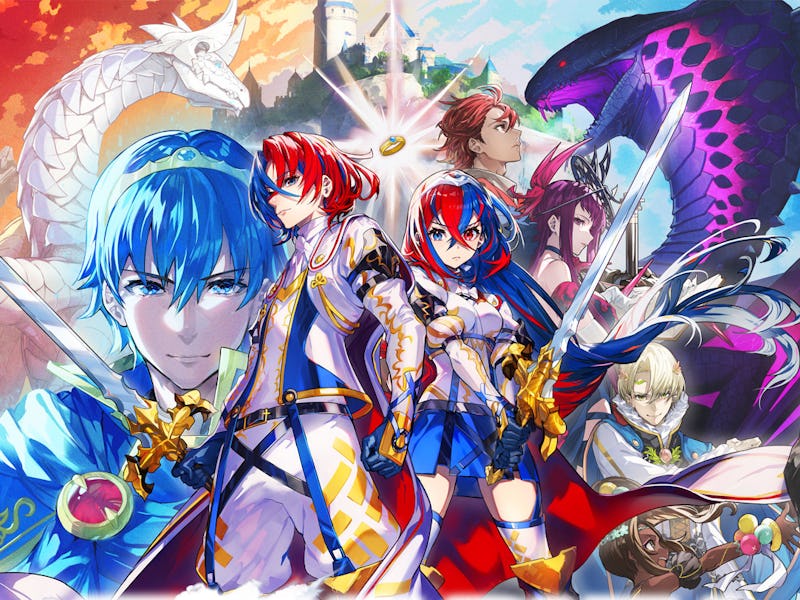Fire Emblem Engage rejects Three Houses’ biggest lessons
More gacha than you might expect.

After the success of 2019’s Fire Emblem: Three Houses, it would be natural to assume developer Intelligent Systems would follow in its footsteps for Fire Emblem Engage. On top of being one of the most critically acclaimed games in the anime-inspired strategy series, Three Houses is the by far the most financially successful, with nearly 4 million sales by the end of 2021.
But that’s less impressive if you count the mobile spin-off Fire Emblem Heroes, a juggernaut of a gacha game that’s made more than $1 billion since launching back in 2017. While it’s not nearly as beloved as Three Houses, Heroes is still a crowd-pleaser, and, well, a billion dollars is hard to ignore. So it shouldn’t come as much of a surprise that Engage seems to take more inspiration from Heroes than from Three Houses.
Fire Emblem Engage’s first trailer revealed its game-changing summon mechanic.
The entire premise of Engage feels like a twist on Heroes. A core mechanic of both games is summoning characters from across the series’ history to join your army. Heroes makes its money by charging players to summon random units, so naturally it’s a bigger deal there, with hundreds of characters to recruit. In Engage, a dozen of Fire Emblem’s most popular heroes appear as the story progresses, summoned from magical Emblem rings.
The two games approach the concept in very different ways. Summons in Heroes are controllable units, and winning the right heroes from its virtual slot machine is essential to advancing through the most difficult content. Engage’s summons instead pair up with other units to unlock stat boosts and powerful new attacks.
Engage does have a secondary summoning system where you can create lesser “bond rings” by spending in-game currency. It’s the game’s most gacha-like mechanic, giving you access to rings representing random characters from previous games, and you can even combine duplicates into more powerful versions.
Fire Emblem Engage characters use the buddy system in combat.
Heroes and Engage handle “summons as characters” in a similar fashion — and frankly, it’s not great. One of the main points of Heroes is amassing a huge collection of jpegs to look respectfully at during battles, so it’s no surprise they’re not given deep characterization. In Engage, their flatness stands out more. At least through Chapter 8 — the cutoff for this preview — your summons are virtual non-entities. They’re extremely important to the plot, but only in the “gotta catch ‘em all” way that Pokémon are important in their series. If you’ve never played the games the summons are pulled from, you’d have no idea why all these sword boys and magic girls are such a big deal, or even what differentiates one from another.
The characters who don’t live in pieces of jewelry fare a lot better. But even they feel like they belong in a different series from Three Houses’ well-defined heroes. The cast of the 2019 game is distinct and memorable, but the cartoonish, exaggerated characters of Engage are far more varied at the outset, in terms of both personality and design.
Three Houses is a masterclass in pacing, slowly building its world and stakes before turning everything on its head in the second half. Engage is a faster game in every sense, for better and worse. The plot wastes no time getting started, and battles come in quick succession, whisking you from one place to another with little break in between.
You’ll spend more time in combat in Fire Emblem Engage and less time chatting with friends at your base.
If you found all the time Three Houses asks you to spend at Garreg Mach micromanaging teammates’ abilities and having tea parties tiresome, Engage might be more your speed. Its home base, the Somniel, has little in common with its predecessor’s sprawling academy. There’s still space for fishing and group dinners, but there are no quests to complete there, nor will you need to set aside any time for lesson plans. Where exploring Garreg Mach feels like a whole other game unto itself, the Somniel is little more than a pit stop between battles.
In combat, too, Engage’s speed is closer to Heroes than Three Houses. Battles can still be long and complex at times, but individual moves and turns are much quicker. One of the biggest successes of Engage’s early game is how fresh its combat feels, as its UI is totally redesigned to display just about every detail you need on one screen. As great as Three Houses is, its battles feel sluggish in comparison, dragged down by how much you need to sift through menus for a single sword swing.
Fire Emblem Engage may not be the Three Houses followup we were expecting, but its unlikely mobile game inspirations could make it an interesting, if divisive, experiment. The quicker, more approachable take on Fire Emblem may gain the series more fans than it loses.
Fire Emblem Engage launches on Nintendo Switch on January 20, 2023.
This article was originally published on